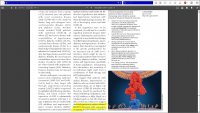md_a
Member
- Joined
- Aug 31, 2015
- Messages
- 468
ACE is also part of the kinin-kallikrein system where it degrades bradykinin, a potent vasodilator, and other vasoactive peptides.
Other less known functions of ACE are degradation of bradykinin and amyloid beta-protein.
Bradykinin is an inflammatory mediator. It is a peptide that causes blood vessels to dilate (enlarge) via the release of prostacyclin, nitric oxide, and Endothelium-Derived Hyperpolarizing Factor.
Bradykinin is a potent endothelium-dependent vasodilator and mild diuretic, which may cause a lowering of the blood pressure. It also causes contraction of non-vascular smooth muscle in the bronchus and gut, increases vascular permeability and is also involved in the mechanism of pain.
During inflammation, it is released locally from mast cells and basophils during tissue damage. Specifically, in relation to pain, bradykinin has been shown to sensitize TRPV1 receptors, thus lowering the temperature threshold at which they activate, thus presumably contributing to allodynia.
Bradykinin is also thought to be the cause of the dry cough in some patients on widely prescribed angiotensin-converting enzyme (ACE) inhibitor drugs.
Therefore, ACE inhibitors, by blocking the breakdown of bradykinin, increase bradykinin levels, which can contribute to the vasodilator action of ACE inhibitors.
ACE2 also cleaves bradykinin.
Overactivation of bradykinin is thought to play a role in a rare disease called hereditary angioedema, formerly known as hereditary angio-neurotic edema.
Bradykinins have been implicated in a number of cancer progression processes. Increased levels of bradykinins resulting from ACE inhibitor use have been associated with increased lung cancer risks. Bradykinins have been implicated in cell proliferation and migration in gastric cancers, and bradykinin antagonists have been investigated as anti-cancer agents.
Bradykinin could also contribute to the pathogenesis of ARDS
Pathophysiology
Proteinases as Mediators of the Disturbance of Pulmonary Vascular Permeability in Sepsis, Polytrauma, and ARDS
Authors
Authors and affiliations
H. NeuhofH. Fritz
Abstract
A series of humoral alterations are a characteristic finding in sepsis, polytrauma, and other affections, which are often followed by an acute lung failure (ARDS, adult respiratory distress syndrome) or multiple organ failure (MOF). Based on experimental and clinical findings, the cooperation of a variety of mediators and mediator systems are responsible for causing the disturbance of vascular tone and permeability and inducing the morphological transformation which finally may result in the failure of vital organs. Beside the classical mediators, such as catecholamines, histamine, serotonin, and bradykinin, increasing attention has recently focused on metabolites of arachidonic acid, cytokines, and products from circulating or resident inflammatory cells. Of all these humoral and cellular alterations the activation and liberation of proteinases seems to play an essential role with regard to loss of capillary barrier function and interstitial edema formation.
Proteinases as Mediators of the Disturbance of Pulmonary Vascular Permeability in Sepsis, Polytrauma, and ARDS
Other less known functions of ACE are degradation of bradykinin and amyloid beta-protein.
Bradykinin is an inflammatory mediator. It is a peptide that causes blood vessels to dilate (enlarge) via the release of prostacyclin, nitric oxide, and Endothelium-Derived Hyperpolarizing Factor.
Bradykinin is a potent endothelium-dependent vasodilator and mild diuretic, which may cause a lowering of the blood pressure. It also causes contraction of non-vascular smooth muscle in the bronchus and gut, increases vascular permeability and is also involved in the mechanism of pain.
During inflammation, it is released locally from mast cells and basophils during tissue damage. Specifically, in relation to pain, bradykinin has been shown to sensitize TRPV1 receptors, thus lowering the temperature threshold at which they activate, thus presumably contributing to allodynia.
Bradykinin is also thought to be the cause of the dry cough in some patients on widely prescribed angiotensin-converting enzyme (ACE) inhibitor drugs.
Therefore, ACE inhibitors, by blocking the breakdown of bradykinin, increase bradykinin levels, which can contribute to the vasodilator action of ACE inhibitors.
ACE2 also cleaves bradykinin.
Overactivation of bradykinin is thought to play a role in a rare disease called hereditary angioedema, formerly known as hereditary angio-neurotic edema.
Bradykinins have been implicated in a number of cancer progression processes. Increased levels of bradykinins resulting from ACE inhibitor use have been associated with increased lung cancer risks. Bradykinins have been implicated in cell proliferation and migration in gastric cancers, and bradykinin antagonists have been investigated as anti-cancer agents.
Bradykinin could also contribute to the pathogenesis of ARDS
Pathophysiology
Proteinases as Mediators of the Disturbance of Pulmonary Vascular Permeability in Sepsis, Polytrauma, and ARDS
Authors
Authors and affiliations
H. NeuhofH. Fritz
Abstract
A series of humoral alterations are a characteristic finding in sepsis, polytrauma, and other affections, which are often followed by an acute lung failure (ARDS, adult respiratory distress syndrome) or multiple organ failure (MOF). Based on experimental and clinical findings, the cooperation of a variety of mediators and mediator systems are responsible for causing the disturbance of vascular tone and permeability and inducing the morphological transformation which finally may result in the failure of vital organs. Beside the classical mediators, such as catecholamines, histamine, serotonin, and bradykinin, increasing attention has recently focused on metabolites of arachidonic acid, cytokines, and products from circulating or resident inflammatory cells. Of all these humoral and cellular alterations the activation and liberation of proteinases seems to play an essential role with regard to loss of capillary barrier function and interstitial edema formation.
Proteinases as Mediators of the Disturbance of Pulmonary Vascular Permeability in Sepsis, Polytrauma, and ARDS




